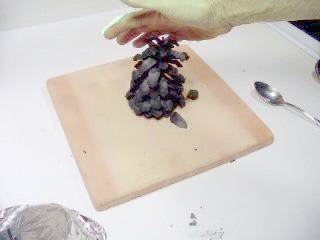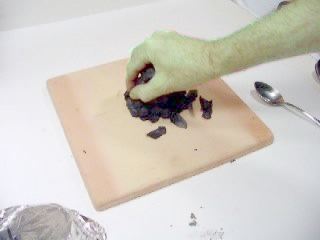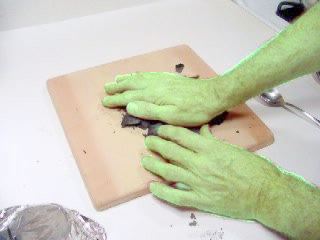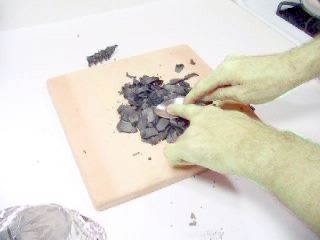An alternative to the mortar and pestle
for making chunky things into fine powder

| Grinder Tile
An alternative to the mortar and pestle for making chunky things into fine powder |
 |
Mortar and Pestle. Love the name. Not a bad thing to have around, either. It's a great little thrash-and-bash device. I use mine a lot. Especially the one in the kitchen, which is good for pestering cumin and other seeds before adding to the soup. Powder the salt before shaking on the French fries. Crack those peppercorns! Haste makes paste!
But one should definitely have another M&P for the lab, and don't get them mixed up. Even though I do not use anything that is very toxic in my propellant, it's just a good idea to keep them far apart.
But my lab mortar is only good for a teaspoon or two at a time. It takes a lot of grinding to get even that small amount to a fine powder.
I recall the days of my poverty-stricken youth. Well that's a lie. The family was fairly wealthy, but the kids did not get much in the way of disposable income. There were no government subsidies to unemployed teenagers in those days. And even when I did get a little money, there were no lab supply stores in the vicinity. And if there were, I probably would have bought something more exciting. Like potassium nitrate.
So I found a spot of cement on the porch that was nice and smooth, and used a table spoon to crush up charcoal to make crude black powder.
Mom did not like the black spot very much, or maybe it was the lingering smell of sulfur. She gently suggested I find another place to do my grinding. I picked up a piece of plywood that worked OK for awhile, but the grinding wore it out pretty quickly. I stumbled around and found an old asbestos shingle with a smooth backside. The house was covered with them, and this one was left over after some remodeling had been done.
It was perfect. With it and a shiny spoon, I could grind a powder so fine that ... that.... well, it made a very fine powder. And I think this was the primary reason I was able to make rockets which worked when none of my high school buddies did. I don't know how hard they tried, they probably had better things to do on Saturday nights. But whatever it was, I could really grind it up. The finer the powder, the better it packs and the faster it burns.
So now, 35 years later, I have been asked by a budding young rocket scientist how to grind things to a powder. That's right up my alley. But asbestos shingles are hardly available, the word asbestos has a curse thrown over it. And I rather doubt that fiberglass tiles or aluminum siding will work the same.
I was in a building supply store awhile back and saw these tiles. They are very plain, unglazed Mexican clay tiles. The surface is smooth but not slick. I bought one. I suspect it will work much like my beloved shingle.
This one is 11-1/2 inches square and about 3/4ths of an inch thick. I chose one with an even surface, no gouges, scratches, or pock-marks. It cost about $2.00.
Choice of a spoon is important too. Do not use the fine silverware! While it might work OK, the social consequences could be dire. Select a stainless steel spoon that might otherwise be thrown away. And if possible, get one that is kinda flat.
Note that the bottom spoon of these three is the flattest, and also the largest. This is the one to use.
Perhaps it is good fortune that the cheapest stainless dinnerware also tends to be the flattest. Is that why they call it "flatware?" Or is to go in the apartment with a flimsy "dinette set?" Let's just hope the steel is good and hard, because it will be subject to considerable abuse.
We will gather a few more bits and pieces as we go along, but now we need something to grind.
I wonder what is in this can...
Hello! It is a pine cone. Recently cooked in the wood stove
to make a fine charcoal.
 |
 |
 |
 |
 |
 |
I start to crush it with the spoon and realize... That's way too much! So I scrape the majority of it off on a 4x6 card for later use, leaving a couple of tablespoons of chips on the board.
The spoon is rocked back and forth over the chunks to break them up into little nuggets.
Then I start going 'round and 'round, trying my best to smear the charcoal into the clay tile.
Not a very absorbent tile, but it is doing its job. The charcoal is becoming dust.
Notice the little white thing under my index finger. The finger is useful for placing greater pressure on the spoon at that point. The neck of the spoon is not strong enough to handle that much pressure for long. It would turn into a goose. The finger exerts most of the pressure, while the handle makes it go around and around. This keeps everything in our dimension, but all that friction makes the spoon hot! So I fold a piece of paper or cardboard to make an insulator, keeping the finger comfortable, if tired. (Hey! I have a little scrap of Nomex in the range box... maybe I'll try that!)
Note that as the charcoal gets finer, the flat black color of the charcoal gives way to a grayish appearance. Things tend to get whiter as they are ground finer. It's one way to know what is well-ground and what isn't.
Around and around some more until every little piece is crushed to atoms, or smaller.
Now to scrape it up. A piece of cardboard serves very nicely. 3x5 cards are OK but a bit on the lightweight side. I prefer to cut a piece of poster-board which works much better. Fortunately, since I've started making my own cases for model rocket motors, there are lots of scraps lying around.
Having scraped most of it loose, I gather it in the middle and scoop it onto the card. Another card can be very helpful here. Or one could just tip it up and dump the stuff onto a sheet of paper...
The powdered charcoal is now resting comfortably in the plastic container.
Let's say I have decided to make a little black powder for ignitors.
My potassium nitrate is all granular. Even the stuff that was a fine
powder when purchased is all chunky now, thanks to the Florida swelter
cycle. So I prepare the tile for another grind. Not a bad idea
to wipe it off, although that is not necessary in this instance - I'm going
to be mixing the KNO3 with charcoal later anyway, so minor contamination
is not an issue. This is just to make the next grind a little prettier.
For some mixtures it would indeed be an issue...
Don't be fooled by the "clean" appearance of the tile. Once a substance has been ground on it, the tile is forever contaminated with traces of that substance. Wiping it, washing it, putting it in the dishwasher, or firing it again in the wood stove won't get everything off, although that wood stove idea is intriguing... So it is important to never use the same tile with incompatible substances, like chlorates after sulfur. I even wonder about the reddish color in this tile. It looks like a tiny bit of red iron oxide to me. Thus I would be cautious about grinding a component for any mixture that might be overly sensitized by this catalyst.
A heaping tablespoon of fertilizer-grade KNO3 goes on the board. Do not adjust your set: This KNO3 does have a bluish tint. Since the grinding spoon is contaminated with charcoal, I am using one of the others as a dipping spoon. As if keeping fertilizer-grade KNO3 "clean" were so important.
The technique will seem similar to grinding charcoal, but crystalline solids have a different texture, and a slightly different technique is required.
The best way to learn? Just do it! you will soon get the
hang of the different materials.
With KNO3, try going around and around, then back and forth and back
and forth, then repeat several times.
Eventually, all the crystals will be reduced in size and the powder can be scraped up.
The back of the spoon does take a beating. I wore out several spoons on the old asbestos shingle.
Note that as a general rule, one should never grind a pyrotechnic mixture. Some mixtures are so sensitive that this kind of friction and pressure can cause them to ignite. Others are less sensitive and grinding of small quantities may be acceptable. Unless you are very familiar with the mixture and its characteristics, and willing to endure the worst-case burn that quantity of that mix could cause, please grind the components separately, then mix gently.
Always wear suitable safety gear when mixing, and do it in a spot where accidental ignition is least likely and least problematic. If the mixture is to be wetted, might as well mix it while wet.
For example: Ignition/Ejection Powder (a.k.a. Black Powder)
Recrystallized Rocketry Home Page
Jimmy Yawn
jyawn@sfcc.net
1/3/04
rev. 7/24/11